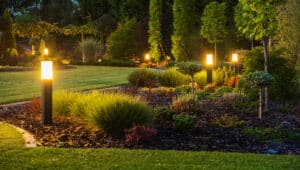Whether you’re just starting on your home-building journey or are in the process of planning your dream home, don’t forget to think about how you want to use lighting! Low voltage lighting is a great way to enhance your home’s aesthetic while providing some practical benefits, too. This post will explore the different design and planning considerations for low voltage lighting in homes. So, whether you’re just getting started or are looking for some inspiration, read on for some helpful tips!
What is Low Voltage Lighting?
Low voltage lighting originated in American residential homes back in the 1950s. It was first for landscape lighting, but people quickly began using it inside because of its ease of use, versatility, and efficiency.
Low voltage lighting is a type of lighting that uses voltages lower than the standard 120 volts used in most homes in the United States. While low voltage lighting has been around for years, it has only become widely available and popular in recent years. There are many different low-voltage lighting fixtures, including LED lights, incandescent bulbs, and halogen lamps. Low voltage lighting is most commonly used for accent, task, or decorative lighting.
One of the main benefits of low voltage lighting is that it is much safer to use than standard 120 volt lighting. This is because low voltage lights produce less heat than their higher voltage counterparts, making them less likely to start fires. Low voltage lighting is also more energy-efficient than standard lighting, saving you money on your energy bills.
Differences in Low Voltage Lighting and Low Voltage Lights
There are two main types of low voltage lighting: line voltage and low voltage. Line voltage lighting fixtures are directly connected to your home’s power lines, while low voltage lighting fixtures use a transformer to reduce the voltage before it reaches the fixture. By installing a voltage transformer, you may still utilize low voltage lights and fixtures with standard electrical wires.
Advantages of Low Voltage Lighting
There are many advantages to low voltage lighting, including:
Energy and Cost-Efficient
Low voltage lighting is also an excellent choice for those looking for more environmentally friendly options. Low voltage lights use less energy than standard lights, which helps to reduce your carbon footprint. They are also more durable than standard lights, so you won’t have to replace them as often. This means that low voltage lighting can save you money overall.
Low Heat
Low-voltage lights, unlike many other competitive bulbs, such as halogen or incandescent, are not hot to the touch and produce minimal heat within their environments. This low heat signature is due to the low wattage required to operate low-voltage lights. As a result, the bulb does not have to work as hard as other light sources, which emits less heat overall. This low heat signature is an important advantage for enclosed spaces, sensitive materials, and areas where children and pets are present.
Safety
As we mentioned before, low voltage lights are much safer to use than their 120-volt counterpart. With lower heat emissions, low wattage bulbs are cooler to the touch, so there is no risk of burns if you come into contact with them.
Versatility
Low voltage lighting is versatile and great for both indoor and outdoor lighting applications. You can use low voltage lights indoors to create a warm and inviting ambiance in your home. They are also perfect for outdoor use, providing safety and security around your home.
You can use low-voltage bulbs in a variety of locations, such as:
- Under-cabinet lighting in the kitchen
- Accent lighting in the living room
- Task lighting in the office
- Landscape lighting around your home’s exterior
- Porch and patio lights
- Pool lights
Low voltage landscape lighting is a great way to highlight your home’s best features and improve curb appeal. You can use low voltage lights to illuminate walkways, accent flower beds, and light up dark areas around your home.
Disadvantages of Low Voltage Lighting
There are a few disadvantages to low voltage lighting, including:
Requires Special Wiring
Low voltage lights require a special wiring system that can be more expensive to install than standard lighting. If you are not familiar with electrical work, it is best to hire an AV and automation professional to install low voltage lighting in your home.
Not as Bright
Low voltage bulbs are not as bright as standard light bulbs, so they may not be suitable for all applications. For example, if you need a lot of light in a particular area, low voltage lighting may not be the best option.
Can be More Expensive
Low voltage bulbs can be more expensive than standard bulbs, although they are typically more energy-efficient in the long run.
How Low Voltage Lighting is Revolutionizing the Smart Lighting Market
Low voltage lighting for homes is one of the latest trends in smart lighting. Until recently, most homeowners were limited to using high voltage lighting for their homes. This typically involved running wiring through the walls and ceilings, which could be expensive and time-consuming.
The use of LEDs in light fixtures has significantly influenced how we utilize lighting. These technological advancements have resulted in new LED lighting systems that employ low-voltage rather than line voltage.
Low-voltage LED lighting plays an increasingly vital role in the residential industry, from basic illumination to home decor to a critical technological component in a home’s operation and design.
Reveals the Full Lighting Potential of a Space
One of the main advantages of low voltage lighting is that it reveals the full lighting potential of a space. This is because they can be placed in areas where it would not be possible to install standard light fixtures. This includes small spaces and tight corners. Low voltage lights can also be used to accentuate architectural features and artwork.
Allows for More Creative Lighting Designs
Another advantage of low voltage lighting for homes is that it allows for more creative lighting designs. Since they can be placed in various locations, you have more options for creating unique and eye-catching lighting schemes. In addition, you can use low voltage LED lights with lighting control to create a warm and inviting atmosphere in your home.
Allows for More Human Centric Lighting Designs
In the past, most lighting was designed to be functional rather than aesthetic. With low voltage lighting, you can create lighting designs that are both aesthetically pleasing and practical. This type of lighting is perfect for human centric lighting designs that take into account how we use light in our everyday lives.
Compatibility with other home automation systems and smart devices
Low voltage lighting is also compatible with other home automation systems and smart devices. This means that you can control your low voltage lights using your smartphone, tablet, or voice-activated assistant. You can also set schedules and timers for your low voltage lights, so they turn on and off automatically.
Now that low voltage LED lighting is available, those looking to integrate technology into their homes have even more design, programming, and installation options. Low voltage lighting provides a safe and effortless way to upgrade your home from security, motorized shading, outdoor living, and home entertainment.
How to Get Low Voltage Lighting in Your Home
Low voltage lighting is a great way to save energy and money, but it can be tricky to know where to start. For retrofit projects, low voltage lighting can be as simple as replacing your existing light bulbs with low-voltage LED bulbs. If you’re starting from scratch with a new build, you’ll need to install a low-voltage transformer. Once you have your low-voltage lighting system in place, you can start enjoying the benefits of lower energy bills and more sustainable home.
Retro and New Build Considerations
There are a few things to keep in mind when planning low voltage lighting for your home, regardless of whether you’re starting from scratch or retrofitting an existing home.
If you’re not planning a new build but are considering retrofitting low voltage lighting into your home, it’s still worth doing some planning beforehand. This will help you avoid having to make major changes to your home’s electrical system and make it easier to install low voltage lighting.
Consider Your Lighting Needs
The first step is to assess your lighting needs. Consider the different tasks performed in each room and the type of atmosphere you want to create. For example, low voltage lighting is often used for accent lighting or task lighting rather than general illumination.
Plan Your Wiring
The next step is to plan your wiring. If you’re starting from scratch with a new build, this will be part of the electrical planning phase. You’ll need to run low voltage cables through the walls and ceilings to each light fixture. If you’re retrofitting an existing home, you may be able to use existing wiring or run low voltage cables alongside standard electrical wiring.
Choose Your Light Fixtures
You’ll need to select the right light fixtures for your needs. There are a variety of low voltage light fixtures available, including recessed lights, track lights, and pendant lights.
Installing Low Voltage Lighting (How to install)
If you’re not familiar with electrical work, it is best to hire a professional to install low voltage lighting in your home. However, if you’re comfortable working with electricity, you can install low voltage lighting yourself.
To install low voltage lighting, you’ll need to:
- Run low voltage cables through the walls and ceilings to each light fixture.
- Connect the low voltage cables to a low voltage transformer.
- Install the light fixtures.
- Test the system to make sure everything is working correctly.
Once you’ve installed low voltage lighting in your home, you can start enjoying the benefits of this energy-saving technology.
Designing with Low Voltage Lighting (Design factors to consider)
There are a few design factors to consider when using low voltage lighting in your home.
Light Output
As mentioned above, low voltage bulbs are not as bright as standard light bulbs. This means that you’ll need to use more low voltage bulbs to achieve the same brightness level.
Color Temperature
Low voltage bulbs come in a variety of color temperatures, from warm white to cool white. Warm white bulbs emit a yellowish light, while cool white bulbs emit a bluish light. The color temperature you choose will depend on the type of atmosphere you’re trying to create in your home.
Dimmability
Many low voltage bulbs are dimmable, which means you can control the amount of light they produce. This is a great way to create different lighting effects in your home and save energy at the same time.
Compatibility
When choosing low voltage bulbs, it’s important to make sure they’re compatible with your transformers and dimmers. Otherwise, you may not be able to take full advantage of their features.
Tips for Seamless Planning and Implementing Low Voltage Lighting in a New Build
Start planning low voltage lighting during the design phase of your new build home. This will give you time to factor in the cost of low voltage lighting and run low voltage cables through the walls and ceilings. Of course, you’ll also need to consider where you want low voltage light fittings to be positioned. But, again, it’s much easier to do this at the design stage than after the home is built.
Key tips for planning and implementing low voltage lighting in a new build home include:
- Make a detailed design & installation plan. This ensures that low voltage lighting is installed where you want it and that the cables are hidden away.
- Position low voltage light fittings during the design phase. This will make it easier to install low voltage cables and avoid damage to your home’s structure.
- Choose low voltage light fittings that are right for the rooms in your home. Consider both function and style when making your selections.
- Pick the right products for your projects. Not all low voltage lighting products are created equal. Do your research to find the best quality products for your needs.
- Find the right wiring. The type of low voltage wiring you’ll need will depend on the products you select. Ensure you get the correct wiring to avoid damage to your home’s electrical system.
- Start with the transformer first. The transformer is the most important part of low voltage lighting. It converts standard voltage to low voltage, making it safe to use in your home.
Planning and installing low voltage lighting in a new build home doesn’t have to be complicated. These tips should ensure a smooth and low-cost installation process.
Low Voltage Lighting for Homes
Low voltage lighting is changing the way we light smart homes. Let AIS help smooth the way with professional low voltage lighting design, installation, and integration services. We work with homeowners and professionals (builders and designers) to implement seamless luxury lighting solutions with simple control.
Contact AIS, your N. Utah low voltage home lighting partner. We also provide 24/7 service and support, as needed, to keep your home’s low voltage lighting system operating at its best. Visit our budget calculator to start planning your next home project!
Related Articles:




